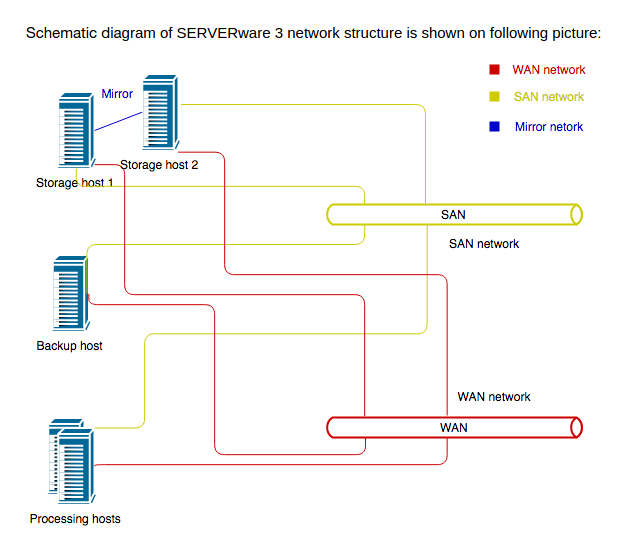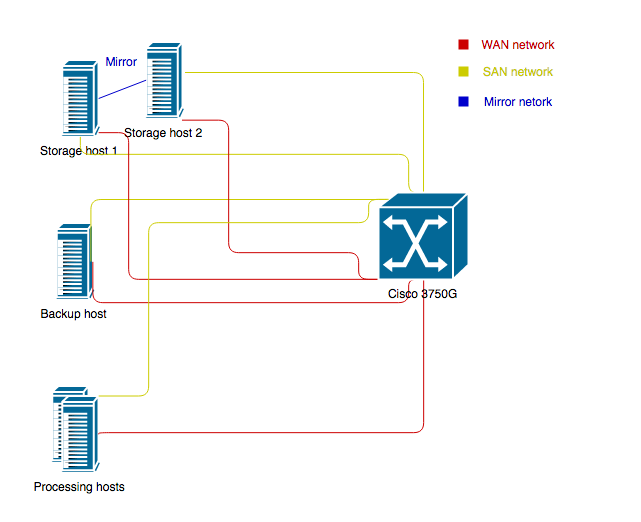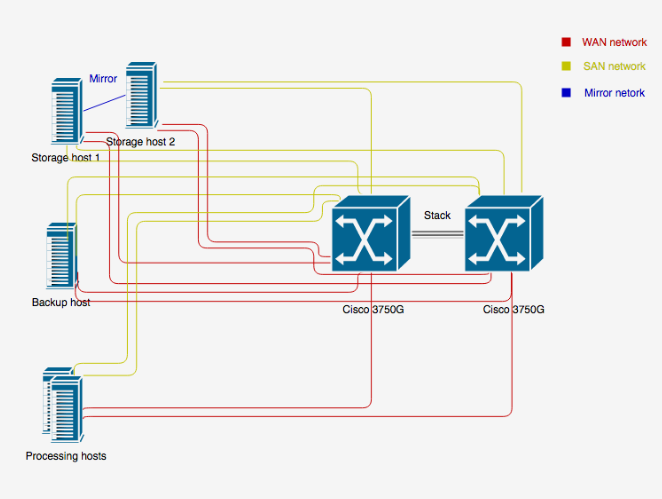¶ Introduction
In following document we will describe network design for SERVERware 4 based on two approaches. First we will describe SERVERware 4 network which doesn’t support redundancy on network level. Second approach is network design based on redundancy on network level, which will allow High Availability of services.
To achieve Highly Availability systems which will provide Fault Tolerant Services with minimum or none service disturbance,network design planning have to be based on redundancy on all levels. This means that all important network components have to be redundant. This document will cover switching level, let’s say up to second network layer. Routing level depend on global network design and can be different from case to case.
Network design is based on Cisco WS-C3750G serie switches.
This layer 3 switch which support all protocols and mechanisms required for redundancy.
Cisco WS-C3750G switch is able to provide following performances:
- 32-Gbps switching fabric
- Stack-forwarding rate of 38.7 mpps for 64-byte packets
- Forwarding rate: 6.5 - 38.7 mpps depends of model
Also following switch features we will use to achieve network redundancy:
-
Cisco CrossStack UplinkFast (CSUF) technology provides increased redundancy and network resiliency through fast spanning-tree convergence
-
(less than 2 seconds) across a switch stack with Cisco StackWise technology.
-
1:N master redundancy allows each stack member to serve as a master,providing the highest reliability for forwarding.
-
Cross-Stack EtherChannel provides the ability to configure Cisco EtherChannel technology across different members of the stack for high resiliency.
-
IEEE 802.1w Rapid Spanning Tree Protocol (RSTP) provides rapid spanning-tree convergence independent of spanning-tree timers and also offers the benefit of distributed processing.
-
Stacked units behave as a single spanning-tree node.
-
Per-VLAN Rapid Spanning Tree (PVRST+) allows rapid spanning-tree reconvergence on a per-VLAN spanning-tree basis, without requiring the implementation of spanning-tree instances.
-
Bandwidth aggregation up to 16 Gbps through 10 Gigabit EtherChannel technology, 8 Gbps through Gigabit EtherChannel technology, and up to 800 Mbps through Fast EtherChannel technology enhances fault tolerance and offers higher-speed aggregated bandwidth between switches and to routers and individual servers.
¶ SERVERware 4 non redundant network design

Above diagram shows typical SERVERware 4 configuration.
System is build around storage hosts, processing hosts and backup host. Two storage hosts configured to work in mirror, provide storage for processing hosts over SAN (Storage Array Network). Processing hosts runs locally VPSes provided over storage network. VPSes use WAN network to provide services to customer.
Backup host provide disk space for backup of VPSes. Backup hosts use storage network to transfer data from storage hosts to local backup disk space.
Because of nature of storage traffic we have to separate SAN traffic from other traffic on network. In case that we have a lot of processing hosts,the best solution is to use dedicated network switch which will server network traffic. In reality situation is that we will use same switch for SAN and all other traffic.
In that case we have to separate traffic using VLAN concept. So for SAN traffic will create SAN VLAN. Other traffic we can keep in default native VLAN. Optionally we can create VLANs for voice traffic and configure prioritize that traffic.
Next schematic diagram shows SERVERware 4 network with one Cisco switch (no network redundancy):

To separate SAN traffic from other traffic on network, we can use VLANs and configure all ports which belongs to SAN network to be members of SAN VLAN.
Here is example of cisco configuration which shows how to configure VLANs on ports:
...
interface GigabitEthernet0/0/1
switchport access vlan 20
switchport mode access
!
interface Vlan20
description “SAN VLAN”
no ip address
...
¶ SERVERware 4 - network redundancy
SERVERware 4 network desing with redundancy on network level is based on two network switches which are connected and configured to work in stack.
Schematic diagram of SERVERware 4 network redundancy is shown on following picture:

As it is shown on above diagram, network in redundancy design is based on two Cisco WS-3750G switches. Switches are connected in stack using appropriate stacking cables. WS-3750G stacking bus support 32-Gbps. Because we have two switches, hosts have to be connected to both switches. This means that for every connection (SAN, WAN),host must have two ethernet interfaces connected to both switches.
This network design allows redundancy on network level. In case that one switch failed, other switch will take over network traffic.
Cisco switch support EtherChannel over Switch Stacks which is necessary and without it
network redundancy will not work.
Same as we provide separation of SAN traffic in non redundant network design, also in redundant network design, to separate SAN traffic from other traffic we will configure appropriate VLANs. Here is example of Cisco switch configuration with network redundancy and VLANs configured to separate SAN traffic:
interface Port-channel5
switchport access vlan 20
switchport mode access
!
interface Port-channel6
switchport access vlan 20
switchport mode access
!
interface Port-channel7
switchport access vlan 20
switchport mode access
!
interface Port-channel8
switchport access vlan 20
switchport mode access
!
…
interface GigabitEthernet1/0/25
description Controller 1 SAN NIC
switchport access vlan 20
switchport mode access
channel-group 5 mode active
spanning-tree portfast
!
interface GigabitEthernet1/0/26
description Controller 2 SAN NIC
switchport access vlan 20
switchport mode access
channel-group 6 mode active
spanning-tree portfast
!
interface GigabitEthernet1/0/27
description Backup SAN NIC
switchport access vlan 20
switchport mode access
channel-group 7 mode active
spanning-tree portfast
!
interface GigabitEthernet1/0/28
description Proco SAN NIC
switchport access vlan 20
switchport mode access
channel-group 8 mode active
spanning-tree portfast
!
…
interface GigabitEthernet2/0/25
description Controller 1 SAN NIC down left
switchport access vlan 20
switchport mode access
channel-group 5 mode active
spanning-tree portfast
!
interface GigabitEthernet2/0/26
description Controller 2 SAN NIC down left
switchport access vlan 20
switchport mode access
channel-group 6 mode active
spanning-tree portfast
!
interface GigabitEthernet2/0/27
description Backup SAN NIC down left
switchport access vlan 20
switchport mode access
channel-group 7 mode active
spanning-tree portfast
!
interface GigabitEthernet2/0/28
description Proco SAN NIC down left
switchport access vlan 20
switchport mode access
channel-group 8 mode active
spanning-tree portfast
!
interface Vlan20
description "SAN VLAN”
no ip address
!
In above example two SAN ethernet interfaces of controller 1 are connected to switch 1 gigabit port 25 and switch 2 gigabit port 25. These two ports on switch 1 and switch 2 forming etherchannel port Port-channel5. On this etherchannel port is configured VLAN 20 which is VLAN for SAN network. Controller 2 is connected to switch 1 gigabit port 26 and switch 2 gigabit port 26. These two ports of switch 1 and switch 2 forming etherchannel port Port-channel6. On this etherchannel port is configured VLAN 20 which is VLAN for SAN
network. Similar is configured on backup and processing hosts. On this way is configured redundancy on network level.